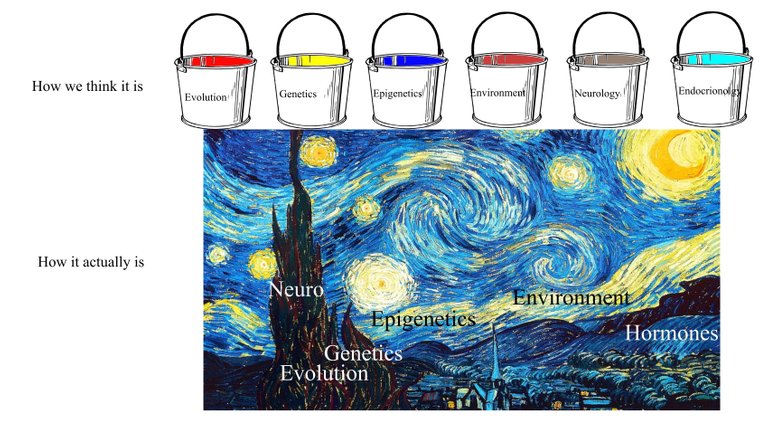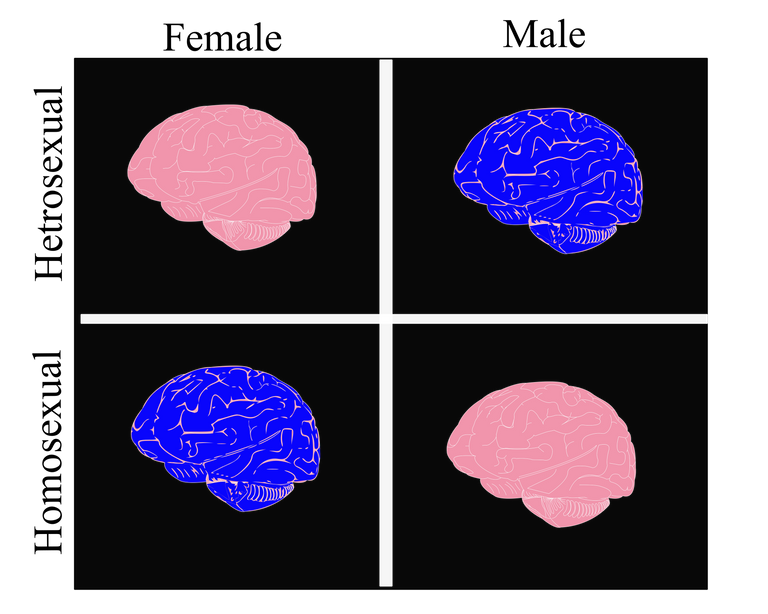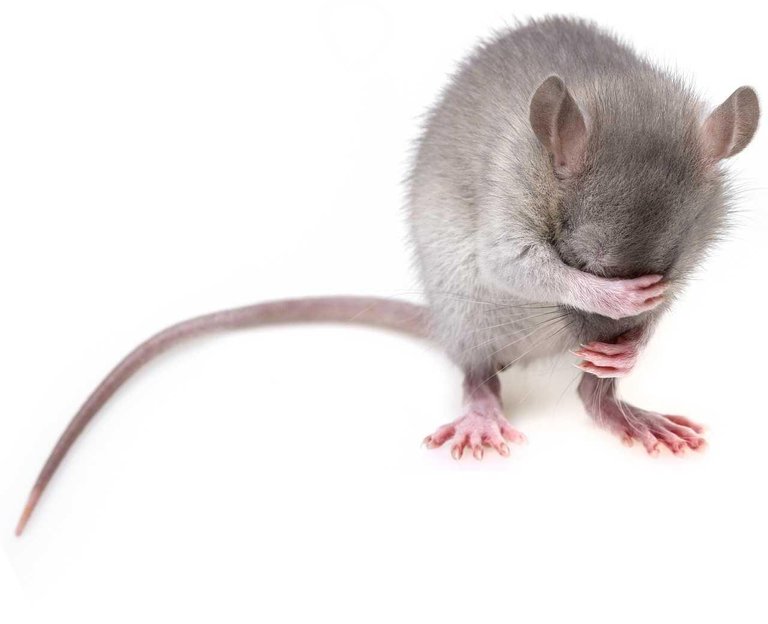A lot of people I meet, often ask - is being gay natural? And I jokingly reply - "you know I have not seen any gay person defying the laws of gravity, motion or thermodynamics, looks pretty natural to me". Then they improvise on their question and ask - "no what I mean is, if it is biological?" Hmm... Well! Let's see.

Image by geralt | CC0
Many people have this bad habit of thinking in categories. And no one is completely immune to it, because categories make life easy. Be it categorising a continuum of wavelengths into colours, or be it categorising academic test scores into grades. However, when trying to dissect the science behind something we need to be careful and avoid the traps. Especially, when we talk about complex traits such as behaviour.

Bucket by OpenClipart-Vectors and The Starry Night by Vincent van Gogh by PerlinatorIllustrated by @scienceblocks using
CC0
If I quote Robert Spolksky lectures(not in exact words) then, if there is a behavioural trait being displayed by an organism - it has to have nervous system and endocrine system involved. You ask what triggered that behaviour, what were the neurons that were firing, which hormones went up, and which came down. Then you ask, why this specific individual turned on that specific neuroendocrine response, why was is it different from common public? Was there a difference in childhood environment, or was there a difference in maternal environment which caused brain structures to develop a certain way. Why did those brain structure develop this way in this individual? Are there genes that causes that, or was it gene environment interaction, or just the environment. Then if there is a genetic component or gene environment component then you wonder, how did that trait pass through the evolutionary filters? Did it provide any direct or indirect advantage? What answers will we get, if we ask these questions in context of human sexuality?
The neuroanatomy of sexuality
The sexually dimorphic brain

brain cartoon by juanadd03 | CC0Illustrated by @scienceblocks using
Sex determination genes not only seem to affect our genitals and body, but also how our brain develops, its chemistry and how it changes through our life. The data about sex differences in the brain of new borns is very limited. Nonetheless, it does seem that morphology of some structures in brain is a function of neonates sex(Knickmeyer et al., 2014). Brain structures also show sex differences in how they develop as the child progresses towards adulthood. For instance both hypothalamus and amygdala increases in size, in both males and females. However, hypothalamus grows much larger in females, while amydala grows larger in males(Giedd et al., 1997). Moreover studies have also suggested sex differences differences in connectome(the total neural network of brain). For instance Ingalhalikar et al., in 2014, suggested that female brains are more optimised for global connections compared to males(wonder if it can explain her being better at multitasking than me!).
Reversed dimorphism in homosexual brain
Anyway, what peeking into the literature revealed is that brain of homosexual men and women, look more like of their respective opposite sex(Savic and Lindstrom, 2008. And, it's not just about the structure of sexually dimorphic brain regions, but the neurochemical responses of these structures differ in homosexuals and hetrosexuals. To give an example, the way brain responds to anti-depressants such prozac is quite different in homosexual vs hetrosexual men(Kinnunen et al., 2004). But, what if you see different neuroanatomy and neurophysiology in homosexuals vs hetrosexuals? What does it mean? How does these anatomical and physiological differences translate to sexuality?
Lessons from animal studies
Drosophila genetics and sexuality

Image taken by André Karwath | CC BY-SA 2.5
Well, it's unethical to poke and modify humans for experiments. But, animal models provide us insights into what might be going on. Take fruitfly for instance. Sexually dimorphic brain structures also exist in flies(Cachero et al., 2010). A gene called fruitless, controls the masculisation of fly brain. It is interesting to note that the way fruitless gene is expressed and spliced differently in male vs female flies. So what happens if you perturb this splicing or look at fruitless mutant male flies? You can switch the courtship behaviour and sexual orientation by changing the splicing pattern. Male having a female like splice variant of fruitless is not so good in bed with females but court with males. On the other hand female with male splice variant displays male sexual behaviour(Demir and Dickson, 2005).
Another gene called genderblind, encodes an amino acid transporter, and is expressed in glial cells of the fly brain(glial cells are the non neuronal cells of the nervous system). The gene was named Genderblind, because mutants of this gene copulate with both males and females(Grosjean et al., 2008). How this gene functions is by controling the strength of glutamatergic synapses in the brain.
Lessons from Rodents

Image by sibya | CC0
In 2010, Park et al mutated a gene called FucM(it produces an enzyme called fucose mutarotase) in mice. Guess what happened? The female mice seemed no more interested in Fuc(ing)-M.They rather were interested in mounting female partners and sniffing female urine. In this case, absence of FucM led to development masculine structures in the brain.
Another aspect of neurochemistry involved in regulating sexuality in mice, is serotonin signalling. Male mice having mutation in serotonin pathway seem to have no sexual preference, while female mice with this mutation prefers scent of other females. In fact researchers were able to manipulate the sexual preference of mice by manipulating serotonin signalling, and that too with no involvement of sex hormones(Zhang et al., 2013).
So from both animal and human studies one thing is pretty clear - sexuality has biological component. You genitals may decide what sex you are. But sexual behaviour and preferences reside in the brain. Which should make you ask when and how do these differences arise?
Of genes and probability

Image by OpenClipart-Vectors
| CC0.
Mate preference in humans is much more complicated than animals. For instance most of the animal studies about neuroanatomy impinges on how their brain reads sex pheromones. The mating preferences in humans depends on any other factors, making complexity inevitable. But before we talk about complexity in context of homosexuality, let's peek into what complexity looks like.
This is what complex traits are made of
In an absolute Mendelian universe, where one gene leads to one function, it would have been easy to pin point the gene for every phenotype. However, not only does a single gene controls multiple function, but often a single function is result of multiple genes interacting with each other. The interaction can either be result of a series of genes acting in a pathway, or each gene adding its own small contribution to final result. The later is a multigenic trait where additive combination of different genes results in a phenotype.
Then, each of these genes do not have to always give the same result. The same gene can interact with the environment. Based on the context it can either switched off or on, or toned up or down by epigenetic modifications(DNA methylation and histone modifications). The environment cam also alter how mRNA is spliced and edited and finally the protein that would be made.
Hence, for complex traits the presence of certain genes only tells you the probability of the phenotype, in a given environment.
A quick look at mathematics of mutigene and environment interaction
Let G be genotype of an organism contains genes {g1, g2,...,gn}. Let E = {e1, e2,...,em} be set of all environmental variables that interact with G. Then Gnm is matrix of all contributions of each g in respective environment e. The gene-gene will have a contribution matrix Gnn...nm. The phenotype will then be a function f(G,E) = Sum(g(i)e(j)). For interacting genes this will fe Sum(g(i)g(k)...g(x)e(j)). Given that this gives to possibility of having the same phenotype in multiple redundant ways, you begin to contemplate the difficulty of pinpointing genes by population studies. For instance if 25% of times one network leads to the phenotype being studies, while 25% of the time its another - you may find some overlapping genes but only with low statistical power.
Genes and sexuality

Image by mcmurryjuie | CC0.
At least from animal studies we saw above, genes can affect mating preferences and sexual orientation. But obviously genes for mating behaviour are not going to be directly controlling your likes and dislikes, like a Facebook like button. Even for animals these were genes that controlled amino acid transport, neurotransmitter signalling or brain development. What it does is, that it tunes your neurons to respond in a certain way to certain pheromones, odours, light, shapes etc. At the end of the day, it's the combination of simple rules that leads to complex patterns of behaviour.
Family and Twin Studies
So, I am not surprised that a single "gay gene" was never discovered. And never would be. However, in order to know, if there is any genetic component whatsoever for a given trait, we can start by asking does it run in family. Simply put if you see a tall person then it's quite likely, that their siblings, cousins are also tall. The accuracy of prediction will depend on that how much the trait depends on the sequence of DNA vs how environment modifies and uses the product of this sequence. Homosexuality is not evenly distributed in population, but appears to be clustered in families. Homosexual females are more likely to have homosexual sisters(Bailey and Benishay, 1993). Male homosexuality also runs in families, though something rather interesting happens with male homosexuality. The pedigree appears to be skewed towards maternal male relatives(Hamer et al., 1993).
The fact that male homosexuality was more frequent for maternal side of homosexual men, made Hamer propose that it is X linked(because males inherit only one X chromosome from their mothers). That is to say that genes for homosexuality lie on X chromosome, or to be specific long arm of X chromosome called Xq28(a region on X chromosome containing about 8 million base pairs). In the meantime, the twin and adoption studies showed that at least 20-40% of homosexuality can be explained by genetic factors(Krik et al., 2000, Santtila et al., 2008). The debate of existence of "gay gene" and linkage of Xq28 continues, but significant advancements have been made. For instance, in 2015, Sanders et al., used a large sample size for genome wide linkage study, and demonstrated a significant linkage of Xq28 for male homosexuality. Apart from Xq28 and other proposed linkages on chromosome 7 and 10, they also found a support for linkage on chromosome 8.
Pinpointing the Genes
There are some interesting genes in the chromosome regions proposed by Sanders. For instance NPBWR1 is gene in the proposed region of chromosome 8, which encodes a receptor in the hippocampus. It's variant has been reported to control the emotional response to facial expressions. CNGA2 is a gene located on Xq28, is expressed in brain. This gene has been shown in mice to be important for response to MHC based odours. Well, if you don't know then, MHC is major histocompatibility complex, and is core of adaptive immune system. Hence, it can have an effect on the microbes that live on your body and the ordors you produce, as well. If you remember those studies, where researchers made women smell sweaty Tshirts of men. Yeah, those ones. Well even though more research is required, there is some evidence that variation of body odour, based on variation in MHC, has a role to play in human mating behaviour, as well(see discussion section of Sanders et al., 2015).
In an attempt to identify more genes, the same group led by Sanders et al., 2017 published another Genome wide association study(aka GWAS). The difference between genome wide linkage and genome wide association, is that in GWAS you look at single nucleotide differences in genomes of people, that could explain the difference. One of the very interesting finding of this study was SLITRK6 gene on chromosome 13. This is because SLITRK genes are proteins on neuronal membranes that helps in growth of neurons and synapse formation. Now guess the region of the brain SLITRK is expressed in? Hint: it is one of the region that differ in size in homo vs heterosexual men. The diencephalon.
Not so surprising that we keep coming back to genes important for neurodevelopment and neurochemistry. Though, the search is not over. What we keep seeing in these studies are small contributors. The mystery won't be solved until we find the entire networks. The network of genes involved not only in neuronal development but also there will be genes that causes subtle differences in how body responds to hormones.
Thyroid function and homosexuality
Talking of hormones. In their GWAS study, Sanders also found a polymorphism in intronic region of gene for thyroid stimulating hormone receptor(TSHR). Now, intronic region is not what contributes to making the final protein product of a gene, but it can have a role in controlling expression of genes, it's spicing and Pre-mRNA processing. TSHR has been linked to autoimmune hyperthyrodism in Grave's disease. Moreover, hyperthyrodism, Grave's disease and lower body weight are common in homosexual men. It does appear that polymorphism in interon of TSHR is also linked with Grave's disease. However, how these mutations leads to either phenotype remains to be elucidated. In the meantime, there is nevertheless a link between the dynamics of X chromosome inheritance and Grave's disease.
Story of biased X-inactivation
Well, even though females inherit two X chromosomes, only one is used by them. In order to prevent genetic overdose the female cells randomly silences one of the two X chromosome. Hence, in normal scenario which X gets silenced has a 50-50 probability. Well, except in some women, were there is a clear bias in silencing of X chromosome. It is intriguing that biased X chromosome silencing has also been observed in mothers of homosexual men(Backlandt et al., 2006). Turns out, that females with Grave's disease also show biased X chromosome inactivation(Brix et al., 2005).
Epigenetics of Sexuality
Now, how X chromosome is inactivated is via epigenetic modification of DNA - which includes adding methylation marks to DNA and histone protein modifications. Most of these epigenetic marks are deleted during gametogenesis (formation of sperm and egg) and a new marks are added de novo during embryonic development. But wait, not every time! It has been observed that epigenetic changes can be passed on to generations and imprinting on X chromosome is no exception. This is what is termed as epigenetic inheritance(see my blog on this). So, while one way to explain biased X inactivation is by DNA methylation is being carried to next generation, the other alternative can be certain sequences on this X chromosome that makes it more likely to get or not get methylated. Alternatively, there could be genes on other chromosomes which via genetic or epigenetic mechanism can cause biased inactivation of X. However, which mechanism cause similar imprinting across generations remains to be explored. Future studies will probably resolve this question.
Nevertheless, apart from inheritance of epigenetic information, epigenetic modifications during development of an embryo have also been implicated in determining sexual orientation. During embryonic development the fetus expresses a gene called SRY. Expression of this gene starts a cascade which leads to development of testes and production of male steroid hormone - testosterone. The cascade also causes repression of genes required for feminising the embryo and production of female hormones. Turns out, that sex hormones also interact with a set of enzymes in the cells called - DNA methyl transferases(DNMTs). These are the enzymes that causes methylation of DNA and hence control gene expression. It seems that female brain needs to suppress masculinization of brain during embryonic development. Testosterone inhibits DNMTs and stops the emasculation of the brain. In fact Nugent et al., 2015 were able to use pharmacological inhibitors of DNMTs and caused masculinization of female rodent's brain. However, keep in mind that testosterone don't explain everything. Not every female exposed to same level of testosterone as male fetish may turn into lesbian. Nor are sex hormones the only environmental variables that affect epigenetics. So there are other forces at work as well.
Maternal environment
The maternal environment might be one of them. Specifically maternal immune environment. For instance having an elder brother increases the chance of younger brother being gay by 33%. The more elders brothers the higher the chance. About 20 to 30% of male homosexuality can be explained by this so called - feternal order effect. The popular hypothesis in this regard is that with every male offspring, some mothers produce an antibody against the peptide(NLGN4Y) on Y chromosome. So, it's just like you mount a stronger immune response against a pathogen you have previously encountered; or the hemolytic disease of new born when Rh blood group of baby doesn't match the mother. The immune response against cells of a male offspring may somehow alter neural development of the newborn and epigenetics of the baby, leading to altered sexual behaviour(Balthazart, 2018). However, the exact mechanism of it remains elusive and requires further exploration.
In fact, there could be more environmental factors apart from immune system and sex hormones, which remain unexplored. And DNA methylation is one of many ways the gene expression can be regulated. There can histone modifications, microRNA genes and even genes involved in RNA splicing and editing that could translate the effect of environment. Also, early childhood stress may as well be involved in turning on and off of these genes. But what is clear from all the discussion above is that variation in human sexuality has biological basis.
Summary
To summarise there are multiple genes that affect neurodevelopment. There is no reason as to why only polymorphism in one gene would alter the brain development and determine sexual orientation of the child. Perturbation at multiple different genetic loci can result in same phenotype in terms of sexual behaviour. The genes can act by a redundant additive effect. The effect is then modulated by environment via epigenetic mechanisms. The candidate genes which affect sexuality either by mutation or environmental regulation fall under genes that regulate neuronal development, response of brain to hormones, neurotransmitter production and reuptake pathways, synaptic strengths in sexually dimorphic areas, and even epigenetic regulators. Given that many variables could lead to same result, it explains why candidate approach to hunt genes will only yield statistically inconsistent results. Nevertheless, the neuroanatomy and neurochemistry that develops in embryonic stage, plus the fact that you can modulate sexual behaviour in controlled labrotory settings via genetic perturbations tells us one thing - sexuality is biological.
Nonetheless, it puts us into a Darwinian dilemma. If homosexuality reduces the rate of reproduction, how does this trait manages to persist in population in so many species? Now, I would have loved to discuss that. But, I think the article is already too long. Hence, for the sake of not testing your patience, I will discuss it in next part. But in the meantime let me know your thoughts in the comments. I would love that.
PS: For lifestyle choice proponents, choices don't arise in thin air. Cognition is biological. So however you see it, there should be no reason for you to call it "unnatural".
References
[Nugent et al., 2015](Nugent BM, Wright CL, Shetty AC, Hodes GE, Lenz KM, Mahurkar A, Russo SJ,
Devine SE, McCarthy MM. Brain feminization requires active repression of masculinization via DNA methylation. Nat Neurosci. 2015.](https://www.ncbi.nlm.nih.gov/pubmed/25821913/?ncbi_mmode=std).Jacques Balthazart, 2018, Fraternal birth order effect on sexual orientation explained, PNAS.
Signing off
@scienceblocks

Congratulations! This excellent post was chosen by the new curation initiative of the @postpromoter content promotion service to receive a free upvote!
This post exemplifies the type of great content that we at @postpromoter enjoy reading and would love to see more of on the Steem platform. Keep up the good work!
Thankyou for those kind and motivating words. And also for your generous upvote.
Man, you've killed it!
I always thought that it's some kind of disorder and that brain structure has the main role, never thought that mothers and x chromosome could be one of the important factors. I really enjoyed reading:)
Thankyou. It feels nice to know when someone enjoys your post. Really appreciate your comment.
I upvoted your post.
Mabuhay, keep steeming.
@Filipino
Posted using https://Steeming.com condenser site.
You got a 15.34% upvote from @postpromoter courtesy of @postcurator!
Want to promote your posts too? Check out the Steem Bot Tracker websitevote for @yabapmatt for witness! for more info. If you would like to support the development of @postpromoter and the bot tracker please
Congratulations,
you just received a 15.73% upvote from @steemhq - Community Bot!
Wanna join and receive free upvotes yourself?

Vote for
steemhq.witnesson Steemit or directly on SteemConnect and join the Community Witness.This service was brought to you by SteemHQ.com
Hi @scienceblocks!
Your UA account score is currently 2.136 which ranks you at #21901 across all Steem accounts.
Your rank has dropped 6 places in the last three days (old rank 21895).Your post was upvoted by @steem-ua, new Steem dApp, using UserAuthority for algorithmic post curation!
In our last Algorithmic Curation Round, consisting of 499 contributions, your post is ranked at #233.
Evaluation of your UA score:
Feel free to join our @steem-ua Discord server